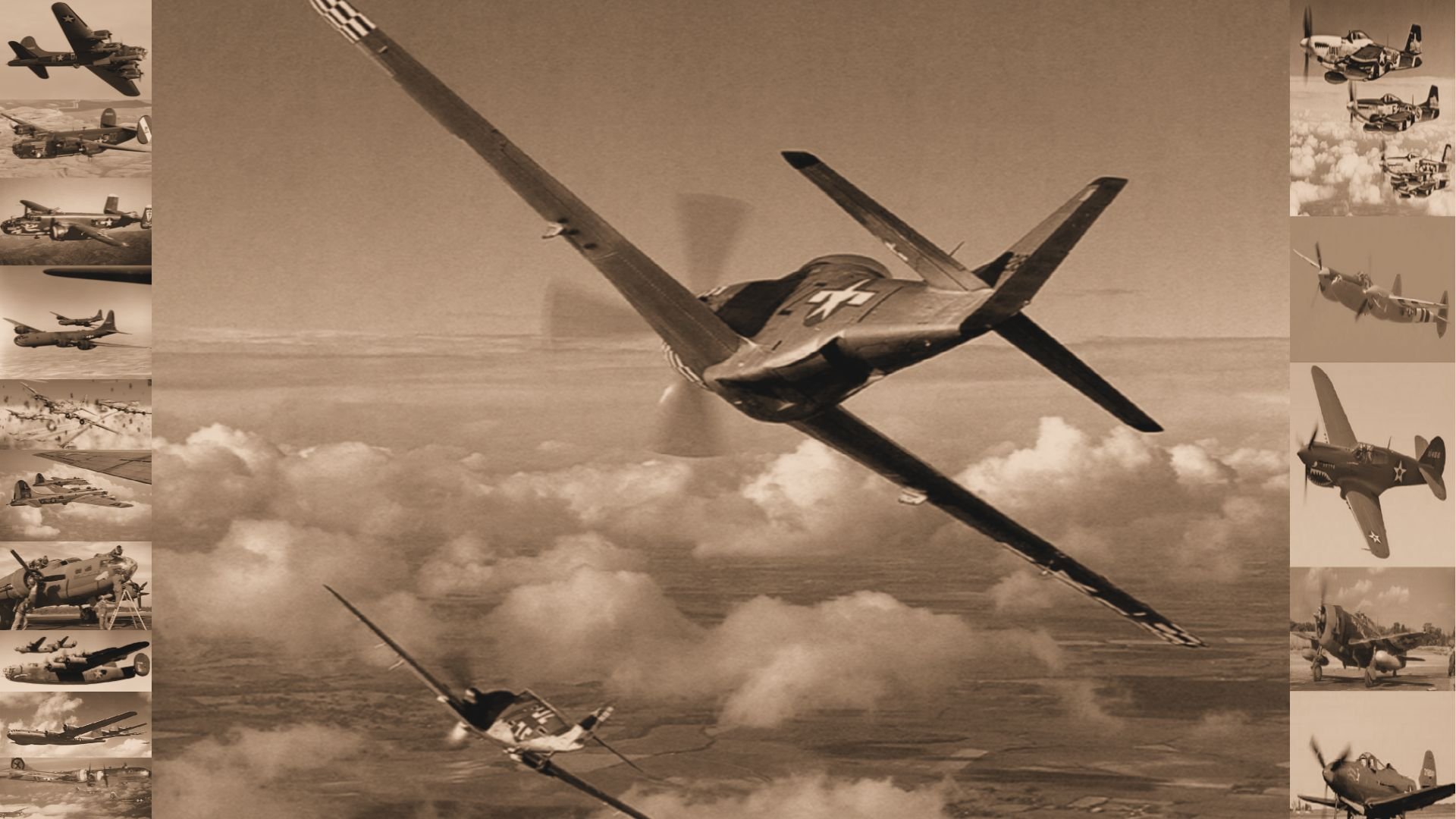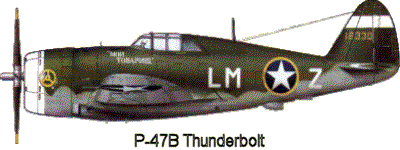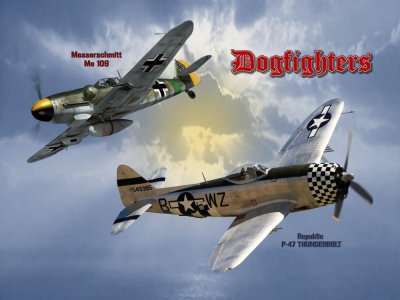 Republic P-47 'Thunderbolt'
Republic P-47 'Thunderbolt'
The Republic P-47 'Thunderbolt' was a World War II-era fighter aircraft produced by the American aerospace company Republic Aviation from 1941 through 1945. Its primary armament was eight .50-caliber machine guns, and in the fighter-bomber ground-attack role it could carry 5-inch rockets or a bomb load of 2,500 lb (1,100 kg). When fully loaded, the P-47 weighed up to 8 tons, making it one of the heaviest fighters of the war.
Back to Top
Development
The P-47 represented the culmination of a line of aircraft which had started way back in 1936 with the Serversky P-35 and which had evolved by the way of the unfortunate P-43 Lancer. Alexander Kartveli, having worked on the P-43 started then to work on 2 submissions, the AP-4(an Allision inline engined fighter) and the AP-10(a 9 tonne fighter). Eventually the Army tested and made orders for over 700 of the XP-47 which became the P-47 'Thunderbolt'. Weighing in at around 9 tonnes, it was the heaviest single engine fighter of the war and with eight .50 calibre machine guns and able to carry bombs, fuel tanks or even bazooka rockets, it made more of an effective ground attack fighter than the P-51 'Mustang' because of its radial engine. Being big, well armoured and having a radial air cooled engine, the P-47 could absorb an enormous amount of damage and still return home. The development of the D model was produced with a 'tear drop' canopy offering the pilot exceptional views for air to air combat. The P-47 served with the United States Army Air Forces (USAAF) until 1949, and with the Air National Guard until 1953, receiving the designation F-47 in 1948. P-47s were operated by several Allied air arms during World War II. The P-47N was the last Thunderbolt variant to be produced. It was designed as an escort fighter for the Boeing B-29 Superfortress bombers flying raids on the Japanese home islands. Increased internal fuel capacity and drop tanks had done much to extend the Thunderbolt's range during its evolution, and the only other way to expand the fuel capacity was to put fuel tanks into the wings. Thus, a new wing was designed with two 50 U.S. gal (190 l) fuel tanks. The redesign proved successful in extending range to about 2,000 mi (3,200 km), and the squared-off wingtips improved the roll rate. The P-47N entered mass production with the uprated R-2800-77(C) engine, with a total of 1,816 built. The very last Thunderbolt to be built, a P-47N-25, rolled off the production line in October 1945.
Back to Top
Into Service
USAAC
The first P-47's were allocated to the 8th Air Force to fly escorts further into Europe than what the previous escorts could do. These were the early version 'Razorbacks' model B and early C's. The first P-47 combat mission took place 10 March 1943 when the 4th FG took their aircraft on a fighter sweep over France. The mission was a failure due to radio malfunctions. All P-47s were refitted with British radios, and missions resumed 8 April. The first P-47 air combat took place 15 April with Major Don Blakeslee of the 4th FG scoring the Thunderbolt's first air victory (against a Focke Wulf Fw190). On 17 August, P-47s performed their first large-scale escort missions, providing B-17 bombers with both penetration and withdrawal support of the Schweinfurt-Regensburg mission, and claiming 19 kills against three losses. The P-47's initial success in combat was primarily due to tactics, using rolls (the P-47 had an excellent roll rate) and energy-saving dive and zoom climbs from high altitude to outmaneuver German fighters. Both the Bf109 and Fw190 could, like the Spitfire, out-turn and out-climb the early model P-47s at low altitude, although at altitudes above 15,000 ft, the P-47 could turn inside both the Me109 and Fw190. The P-47 proved to be a formidable fighter-bomber due to its impressive armament, bomb load and ability to survive enemy fire. It's eight .50 in (12.7 mm) machine guns could inflict severe damage on lightly armored targets. In a ground attack role, the armor-piercing (AP), armor-piercing incendiary (API), and armor-piercing incendiary tracer (APIT) ammunition proved useful in penetrating thin-skinned and lightly armored German vehicles and exploding their fuel tanks, as well as occasionally damaging some types of enemy armored fighting vehicles.
Back to Top
Pacific
By mid-1943, the 'Jug' (as it was affectionately known by its pilots) was also in service with the 12th Air Force in Italy, and it was fighting against the Japanese in the Pacific with the 348th Fighter Group flying escort missions out of Brisbane, Australia. Pilots were taught to use the speed of the P-47 in diving and braking away rather than tangle with the more manouverable Japanese fighters like the Nakajima Ki-43 'Oscar' and the Mitsubishi A6M 'Zero'. By 1944, the P-47 was in combat with the USAAF in all its operational theaters, except Alaska. In late June 1945, they were ranging over Honshu Japan where in one battle they bounced a flight of N1K2 'George' fighters of the 343 Kokutai (Gendas Squadron of Aces) and subsequently shot all 7 of the flight down with no losses.
Back to Top
RAF
The RAF received 240 'Razorback' P-47Bs which they designated "Thunderbolt Mark I", and 590 Bubbletop P-47D-25s, designated "Thunderbolt Mark IIs". With no need for another high-altitude fighter, the RAF adapted their Thunderbolts for ground attack, a task for which the type was well suited.
Back to Top
Soviet Air Force (VVS)
The U.S. sent 203 P-47Ds to the Soviet Union. In mid-1943, the Soviet high command showed an interest in the P-47B. Three P-47D-10-REs were ferried to the Soviet Air Forces (VVS) via Alaska in March 1944. Two of them were tested in April-May 1944. With its high service ceiling, the P-47 was superior to fighters operating on the Eastern front, yielding a higher speed above 30,000 feet (9,100 m). The Yakovlev Yak-9, Lavochkin La-5FN, Messerschmitt Bf 109G, and Focke-Wulf Fw 190A outperformed the early model P-47 at low and medium altitude, where the P-47 had poor acceleration and performed aerobatics rather reluctantly. In mid-1944, 200 P-47D-22-REs and P-47D-27-REs were ferried to the USSR via Iraq and Iran. Many were sent to training units. Less than half reached operational units, and they were rarely used in combat. The fighters were assigned to high-altitude air defense over major cities in rear areas. The VVS made little use of the P-47 as a ground-attack aircraft, depending, instead, on their own widely produced-with 36,183 examples built during the war-special-purpose, armored ground-attack aircraft, the Ilyushin Il-2. At the end of the war, Soviet units held only 188 P-47s.
There was a call amongst many pilots flying P-51 'Mustangs' to reintroduce the P-47's for ground attacks in the Korean War. The P-47 could take much more punishment and a heavier payload, however, as the P-51's were still actively used by the USAF, the cost would have been prohibitive and by the time they were refurbished and transported overseas, jets like the P-80 'Shooting Star', F-84 'Thunderchiefs' as well as US Navy and Commonwealth jets were already providing ground attack support and therefore was deemed impracticle.
The P-47 was one of the heaviest fighters used during World War 2 and its value was reflected in the numbers built during the war. A total of 15,678 Thunderbolts of all types were built. Today there are but a few examples left in flying condition.
Back to Top




